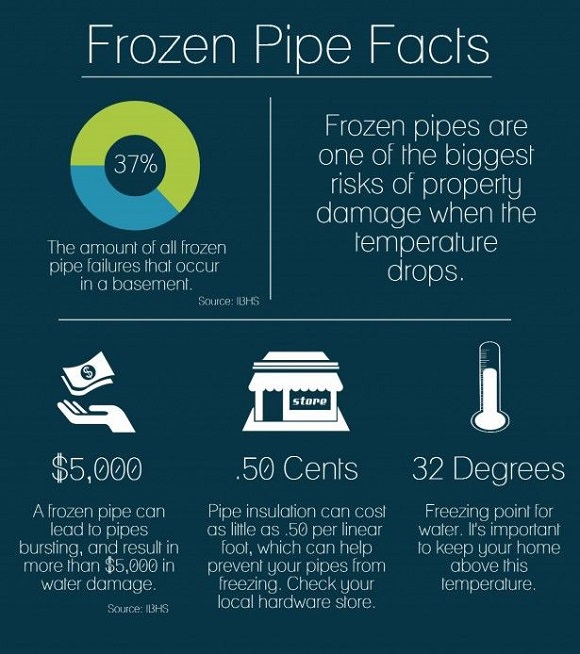When water freezes, it expands. That’s why a can of soda explodes if it’s put into a freezer to chill quickly and forgotten. When water freezes in a pipe, it expands the same way. If it expands enough, the pipe bursts, water escapes and serious damage results.
WHY PIPES BURST
Surprisingly, ice forming in a pipe does not typically cause a break where the ice blockage occurs. It’s not the radial expansion of ice against the wall of the pipe that causes the break. Rather, following a complete ice blockage in a pipe, continued freezing and expansion inside the pipe causes water pressure to increase downstream — between the ice blockage and a closed faucet at the end. It’s this increase in water pressure that leads to pipe failure. Usually the pipe bursts where little or no ice has formed. Upstream from the ice blockage the water can always retreat towards its source, so there is no pressure build-up to cause a break. Water must freeze for ice blockages to occur. Pipes that are adequately protected along their entire length by placement within the building’s insulation, insulation on the pipe itself, or heating, are safe.
Generally, houses in northern climates are built with the water pipes located on the inside of the building insulation, which protects the pipes from subfreezing weather. However, extremely cold weather and holes in the building that allow a flow of cold air to encounter pipes can lead to freezing and bursting.
In existing houses, a plumber may be able to re-route at-risk pipes to protected areas, although this may not be a practical solution. If the latter is the case, vulnerable pipes that are accessible should be fitted with insulation sleeves or wrapping (which slows the heat transfer), the more insulation the better. It is important not to leave gaps that expose the pipe to cold air. Hardware stores and home centers carry the necessary materials, usually in foam rubber or fiberglass sleeves. Better Water pipes in houses in southern climates often are more vulnerable to winter cold spells. yet, plumbing supply stores and insulation dealers carry pipe sleeves that feature extra-thick insulation, as much as 1 or 2 inches thick. The added protection is worth the extra cost. Cracks and holes in outside walls and foundations near water pipes should be sealed with caulking to keep cold wind away from the pipes. Kitchen and bathroom cabinets can keep warm inside air from reaching pipes under sinks and in adjacent outside walls. It’s a good idea to keep cabinet doors open during cold spells to let the warm air circulate around the pipes. Electric heating tapes and cables are available to run along pipes to keep the water from freezing. These must be used with extreme caution; follow the manufacturer’s instructions carefully to avoid the risk of fire, and check to make sure the product conforms to UL 2049. Tapes and cables with a built-in thermostat will turn heat on when needed. Tapes without a thermostat must be plugged in each time heat is needed and may be forgotten.
LETTING THE WATER RUN
Letting a faucet drip during extreme cold weather can prevent a pipe from bursting. It’s not that a small flow of water prevents freezing; this helps, but water can freeze even with a slow flow. Rather, opening a faucet will provide relief from the excessive pressure that builds between the faucet and the ice blockage when freezing occurs. If there is no excessive water pressure, there is no burst pipe, even if the water inside the pipe freezes. A dripping faucet wastes some water, so only pipes vulnerable to freezing (ones that run through an unheated or unprotected space) should be left with the water flowing. The drip can be very slight. Even the slowest drip at normal pressure will provide pressure relief when needed. Where both hot and cold lines serve a spigot, make sure each one contributes to the drip, since both are subjected to freezing. If the dripping stops, leave the faucet(s) open, since a pipe may have frozen and will still need pressure relief.
IF YOU SUSPECT A FROZEN PIPE
If you open a faucet and no water comes out, don’t take any chances. Call a plumber. If a water pipe bursts, turn off the water at the main shut-off valve (usually at the water meter or where the main line enters the house); leave the faucet(s) open until repairs are completed. Don’t try to thaw a frozen pipe with an open flame; as this will damage the pipe and may even start a building fire. You might be able to thaw a pipe with a handheld hair dryer. Slowly apply heat, starting close to the faucet end of the pipe, with the faucet open. Work toward the coldest section. Don’t use electrical appliances while standing in water; you could get electrocuted.
GOING ON A TRIP
When away from the house for an extended period during the winter, be careful how much you lower the heat. A lower temperature may save on the heating bill, but there could be a disaster if a cold spell strikes and pipes that normally would be safe, freeze and burst. A solution is to drain the water system. This is the best safeguard. With no water in the pipes, there is no freezing. This remedy should be considered even when the homeowner is not leaving but is concerned about a serious overnight freeze. To drain the system, shut off the main valve and turn on every water fixture (both hot and cold lines) until water stops running. It’s not necessary to leave the fixtures open, since the system is filled mostly with air at that point and not subject to freezing. When returning to the house, turn on the main valve and let each fixture run until the pipes are full again.
Space Heater Safety
Adapted from the Electrical Safety Foundation International (ESFI)
Heating equipment is the second leading cause of home fires in the United States. More than 65,000 home fires are attributed to heating equipment each year. These fire result in hundreds of deaths, thousands of injuries and millions of dollars in property damage.
Portable electric space heaters can be a convenient source of supplemental heat for your home in cold weather. Unfortunately, they can pose significant fire and electric shock hazards if not used properly. Fire and electrical hazards can be caused by space heaters without adequate safety features, space heaters placed near combustibles, or space heaters that are improperly plugged in.
Safety should always be a top consideration when using space heaters. Here are some tips for keeping your home safe and warm when it’s cold outside:
Make sure your space heater has the label showing that it is listed by a recognized testing laboratory.
Before using any space heater, read the manufacturer’s instructions and warning labels carefully.
Inspect heaters for cracked or broken plugs or loose connections before each use. If frayed, worn or damaged, do not use the heater.
Never leave a space heater unattended. Turn it off when you're leaving a room or going to sleep, and don't let pets or children play too close to a space heater.
Space heaters are only meant to provide supplemental heat and should never be used to warm bedding, cook food, dry clothing or thaw pipes.
Install smoke alarms on every floor of your home and outside all sleeping areas and test them once a month.
Proper placement of space heaters is critical. Heaters must be kept at least three feet away from anything that can burn, including papers, clothing and rugs.
Locate space heaters out of high traffic areas and doorways where they may pose a tripping hazard.
Plug space heaters directly into a wall outlet. Do not use an extension cord or power strip, which could overheat and result in a fire. Do not plug any other electrical devices into the same outlet as the heater.
Place space heaters on level, flat surfaces. Never place heaters on cabinets, tables, furniture, or carpet, which can overheat and start a fire.
Always unplug and safely store the heater when it is not in use.




